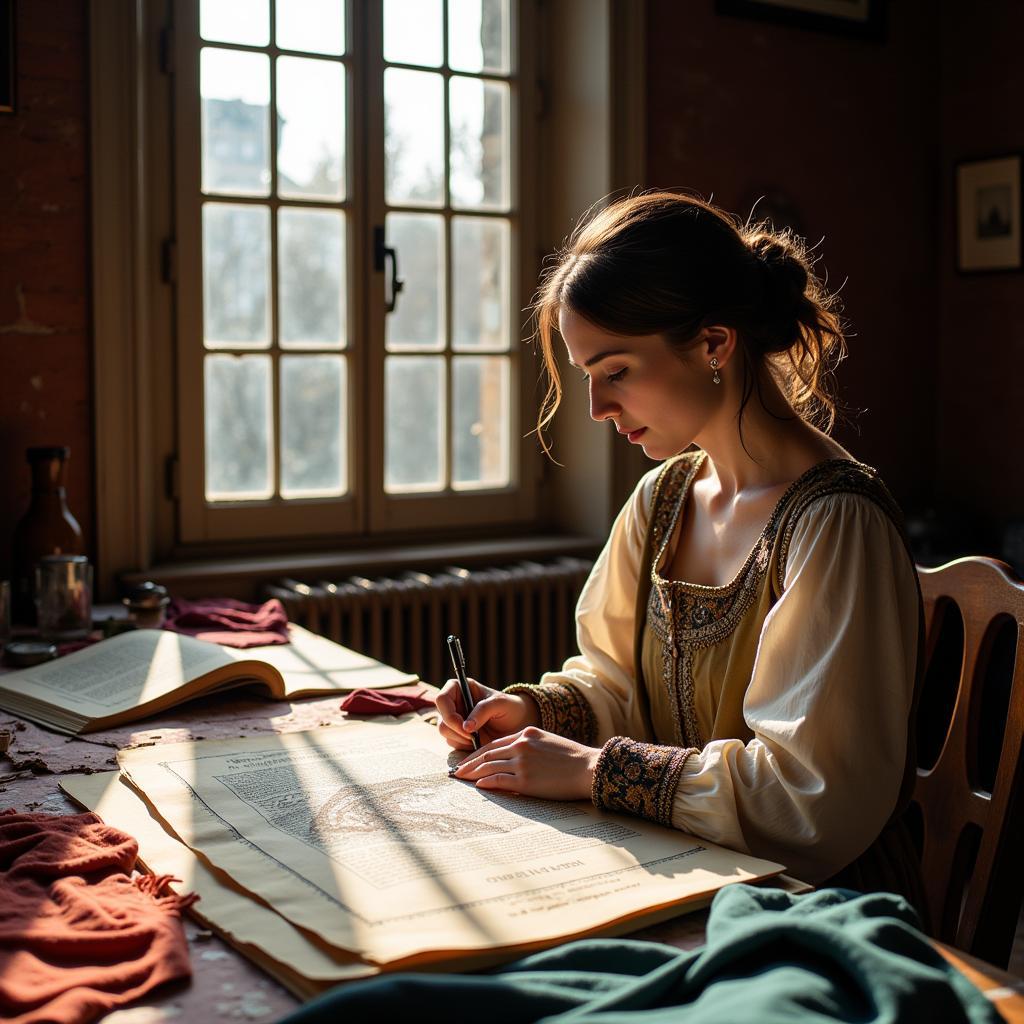The Society for Creative Anachronism (SCA) offers a unique blend of history, artistry, and community. Society For Creative Anachronism Garb plays a vital role in this immersive experience, transporting members to a bygone era. From the simplest tunic to the most elaborate gown, each garment tells a story, reflecting both historical accuracy and individual creativity. This article delves into the world of SCA garb, exploring its significance, creation, and the profound impact it has on the SCA community.
Crafting History: The Importance of SCA Garb
SCA garb is more than just clothing; it’s a tangible connection to the past. By meticulously researching and recreating historical garments, members gain a deeper understanding of the people and cultures that inspired them. This dedication to authenticity fosters a sense of community and shared purpose, strengthening the bonds between members. The act of creating garb, whether through sewing, weaving, or other crafts, is a journey of discovery. After the first few paragraphs, let’s delve into some resources for finding the perfect attire. For those interested in exploring ready-made options, the society for creative anachronism clothing page provides a valuable starting point.
Unveiling the Past: Researching and Designing Your Garb
The process of creating SCA garb begins with research. Members delve into historical sources, examining artwork, manuscripts, and archaeological findings to understand the clothing of their chosen time period and culture. This research informs the design and construction of their garb, ensuring accuracy and authenticity. This attention to detail not only enriches the individual’s experience but also contributes to the overall historical atmosphere of SCA events.
 Researching and Designing SCA Garb
Researching and Designing SCA Garb
From Concept to Creation: The Art of Garb Making
Once the research is complete, the actual creation of the garb begins. This process can involve a variety of skills, from basic sewing to complex embroidery and embellishment. Many members find joy in learning and mastering these traditional crafts, further deepening their connection to the past. The shared knowledge and collaborative spirit within the SCA create a supportive environment for learning and skill development. Sometimes, legal issues can arise within the community, and understanding these complexities is essential. You can find more information on this topic on our society for creative anachronism lawsuit page.
What are the most common fabrics used in SCA garb?
Linen and wool are the most commonly used fabrics, reflecting the materials readily available in the past.
How long does it take to make a piece of SCA garb?
The time required varies greatly depending on the complexity of the garment, from a few hours for a simple tunic to weeks or even months for an elaborate gown.
Embracing Diversity: Different Cultures and Eras in SCA Garb
The SCA encompasses a vast range of historical periods and cultures, from medieval Europe to ancient Rome and beyond. This diversity is reflected in the incredible variety of garb seen at SCA events. Each garment tells a unique story, showcasing the creativity and craftsmanship of its wearer. Witnessing this vibrant tapestry of historical clothing is truly a sight to behold.
Beyond the Garb: The Impact on Community and Personal Growth
SCA garb is more than just clothing; it’s a symbol of belonging and shared passion. It fosters a sense of community, connecting individuals through a shared love of history and craftsmanship. The process of creating and wearing garb also contributes to personal growth, encouraging creativity, skill development, and a deeper understanding of oneself and the past. Maria Perez, a renowned SCA artisan, shares her perspective, “Creating garb is a transformative experience. It’s not just about the finished product; it’s about the journey of learning, creating, and connecting with others who share your passion.” John Smith, a long-time SCA member, adds, “Wearing garb allows me to step into another time and place, to experience history in a tangible way. It’s a powerful and enriching experience.”
 The Community Impact of SCA Garb
The Community Impact of SCA Garb
Conclusion
Society for creative anachronism garb is an integral part of the SCA experience, connecting members to the past, fostering creativity, and strengthening the bonds of community. From the meticulous research to the skillful creation, each garment tells a story of dedication, passion, and a shared love of history.
FAQ
- Where can I find patterns for SCA garb?
- What are some common mistakes to avoid when making SCA garb?
- Are there any restrictions on the type of garb I can wear?
- How can I learn more about historical clothing and textiles?
- What are some good resources for finding affordable garb materials?
- Can I wear modern clothing at SCA events?
- Are there specific garb requirements for different roles within the SCA?
We encourage you to explore other related articles on our website. For any assistance, please contact us at Phone Number: 02043854663, Email: [email protected] or visit our address: Khu 34, Bac Giang, 260000, Vietnam. Our customer service team is available 24/7.